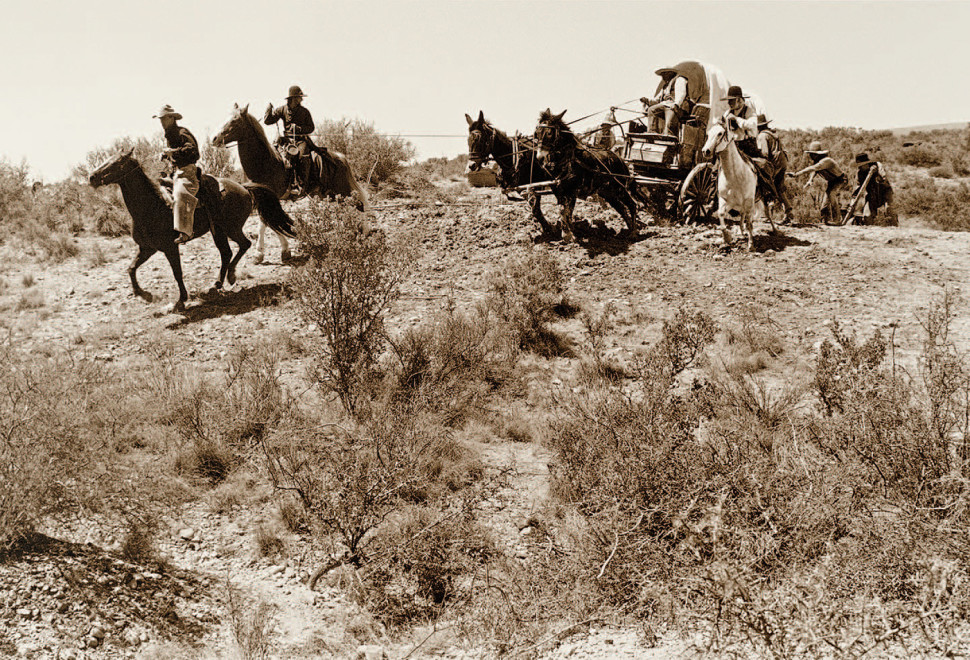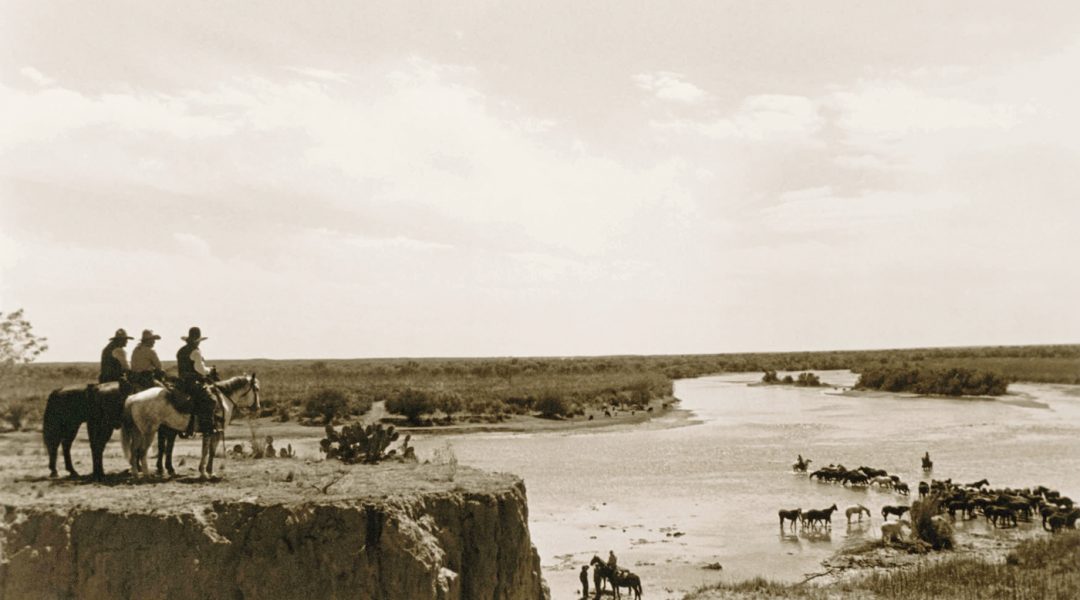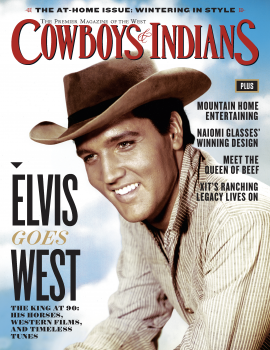On the 25th anniversary of the epic western, C&I goes behind the scenes with director Simon Wincer.
If John Wayne hadn’t heeded the advice of John Ford, Larry McMurtry might never have written the Pulitzer Prize-winning novel Lonesome Dove. If James Garner had been in better health at the time the novel was adapted into an epic miniseries, he, not Robert Duvall, likely would have been cast as Augustus “Gus” McCrae.
And if scriptwriter-executive producer Bill Wittliff had ordered something other than oysters during a preproduction dinner with director Simon Wincer, someone other than the Australian-born filmmaker probably would have taken the reins.
Yes, it’s all true. As McMurtry and director Peter Bogdanovich often have noted, they were greatly pleased by the result of their first collaboration — The Last Picture Show, the classic 1971 film based on McMurtry’s novel — and hoped to reunite for a second project, a western with the working title Streets of Laredo. Bogdanovich had hoped to sign John Wayne, James Stewart, and Henry Fonda for lead roles in the film. But when Ford cautioned Wayne not to be part of the elegiac western drama, The Duke dropped out, and the project fell apart. Years later, McMurtry reworked his original script into a novel titled Lonesome Dove.
As it turned out, McMurtry later wrote a sequel to Lonesome Dove and called that book Streets of Laredo. When it was adapted into a 1995 miniseries, James Garner essayed the lead role of retired Texas Ranger Woodrow F. Call. But back when Lonesome Dove was filmed in 1988 for a 1989 airdate, Garner was offered the part of Call’s longtime buddy, Gus McCrae. When he had to pass on the part, Duvall got the phone call he’d been hoping for.
Lonesome Dove was green-lit for production in 1988 by CBS, the same TV network that had recently aired two well-received miniseries directed by Simon Wincer — The Last Frontier (1986), a drama about cattle ranchers in Australia, and Bluegrass (1988), set in the world of Thoroughbred racing. Because of Wincer’s TV track record, and because he had also directed features back in his native Australia, CBS executives were comfortable with the idea of him at the helm of Lonesome Dove, a massive undertaking that, as Wincer recalls, “would be the equivalent of making four films in 16 weeks.”
The network executives, Wincer says, looked at him as “the guy who could shoot [the miniseries on] a television schedule and give it a feature look.” In turn, Wincer felt confident he was up to the challenge, despite his lack of experience as a director of traditional Wild West dramas. “I wasn’t preconditioned by Hollywood westerns and stuff like that,” he says, “so I brought a fresh look to the whole western genre, if you like.”
But not everyone else associated with the project was so quick to accept Wincer. As screenwriter and executive producer of Lonesome Dove, the Texas-born Wittliff — who had written screenplays for Raggedy Man (1981), Barbarosa (1982), and Country (1984), among other features — had veto power over who would get hired as director. And he was slow to acknowledge Wincer’s suitability for the job. Indeed, even after he viewed Wincer’s The Lighthorsemen, a large-scale 1987 feature about a World War I light horse unit’s experiences during the 1917 Battle of Beersheba, Wittliff remained unconvinced.
“I took Simon to dinner,” Wittliff remembers, “and I really planned to tell him that we were going to go with somebody else. I’d ordered oysters, and just when I was about to say ‘I can’t do this,’ I looked down into one of the oysters and I saw a pearl. Well, I’d never had that happen to me before. And, yeah, I’m kind of superstitious. So I told Simon we were going to go with him.”
After a lengthy preproduction period, Wincer mounted up and headed out on a three-and-a-half-month journey through Texas and Mexico that began March 21, 1988. The following February, tens of millions of viewers tuned in to CBS to appreciate his handiwork — at a time, Wittliff still marvels, when “the only thing on TV deader than the miniseries was the western.”
Duvall and Tommy Lee Jones rode tall as Gus and Call, two former Texas Rangers turned resilient cattle drivers. They were backed by a stellar ensemble that included Rick Schroder as Newt Dobbs, the son Call came to respect but never really acknowledged; Danny Glover as Joshua Deets, the guide who proved too good-hearted for his own good; the late Robert Urich as Jake Spoon, another former Texas Ranger, who inspired Gus and Call to drive cattle to Montana but then fell in with bad companions; Diane Lane as Lorena Wood, a young prostitute who was seduced by Jake’s smooth talk but drawn to the supportive Gus; Chris Cooper as July Johnson, the sheriff who set out to bring Jake to justice; and Anjelica Huston as Clara Allen, the woman who never forgave Call for luring Gus away from her.
But it was Wincer, not any of his on-camera collaborators, who won an Emmy for Lonesome Dove. (Other behind-the-scenes contributors, including composer Basil Poledouris and costume designer Van Broughton Ramsey, were similarly honored.) To mark the 25th anniversary of the original CBS telecast, the director graciously agreed to a phone interview from his cattle ranch near Melbourne, Victoria, about his pivotal role in the production of what many revere as the greatest western ever made.

Cowboys & Indians: At the time you filmed Lonesome Dove, did you find some people were skeptical as to whether an Australian filmmaker could do justice to the novel that’s been called the Gone With the Wind of Texas?
Simon Wincer: Well, as I’ve said many times, I felt like I had all of Texas looking over my shoulder when I started work on Lonesome Dove. So first we had a screening of The Lighthorsemen for the whole crew two days before we started shooting. And that gave everyone confidence in me. Particularly Tommy Lee. He said, “I love the way you shoot horses.” And because he’s also a horseman, we had something in common as well.
And then we had our American premiere of The Lighthorsemen in Houston — just when we were into our second week of shooting Lonesome Dove. I flew in for the premiere right after we finished shooting that scene in the bar where Bobby Duvall whacks the guy across the face with his gun. I literally jumped onto the plane right after we finished that in Austin [Texas] and flew into Houston. Then I had to fly back to Austin the next morning. And I think the next day, the guy covering [the movie premiere] for the Houston Chronicle wrote something to the effect of, “OK, we can relax. This guy knows what he’s doing with our book.”
C&I: It’s pretty much accepted now as part of the Lonesome Dove mythos that you and Robert Duvall weren’t exactly friendly co-workers. Did you two really clash that much during filming?
Wincer: It’s no secret that I had my share of conflicts with Robert Duvall. But I’ve since heard that he’s had a rough ride with most of the directors he’s worked with. I got along well with Tommy Lee and just about everybody else. But, look, that’s just the way Duvall works. You’ve got to accept that and get on with it. He’s a wonderful actor — and, really, that’s all that counts.
I remember one absolutely magic moment in the film, the scene where they hang Jake Spoon. When the horse runs forward and leaves Jake to hang, the reaction on Duvall’s face is absolutely extraordinary. That’s such a powerful moment in the movie. But the thing is, when we showed him the first cut, we’d used a different take, by sheer accident. I hadn’t done the fine cut yet, and I’m sure that we would have found that take eventually. But Duvall picked that up straight away. He asked us to please use that other shot of him. And he was right.
C&I: According to most accounts, Duvall and Tommy Lee Jones are very different people, with very different approaches to their craft. Yet it’s hard to imagine a more perfect pairing for this particular project, to tell this particular story.
Wincer: That’s the magic of working with actors of that caliber. Like in the scene when Call comes to visit Gus on his deathbed. It’s an intimate scene — just a two-hander — and it’s just extraordinarily powerful. You have these two great actors. And we literally shot it in two and a half hours. But they obviously had their words down, and they knew what they wanted to do. I think we ran through it once, and then we set up a couple of cameras. And then we had magic. You could have heard a pin drop on the set, because you had everyone working there riveted by these two wonderful actors.
And Gus’ dying moment — that was all Bobby’s idea. He seems to fade away, but then he wakes up again. And I think his last line is, “It’s been quite a party.” Just amazing.
C&I: Directors of westerns often talk about the trouble they’ve had with actors who exaggerate their skills as horsemen during auditions and then prove less than comfortable in the saddle during actual filming. Did you ever have that kind of problem on Lonesome Dove?
Wincer: Not really. Tommy Lee already was a very good rider, because he was a very good polo player. And Bobby was a very good rider — he put a lot of work into it. Ricky Schroder and D.B. Sweeney and that lot were basically new to the saddle. They did the really intensive four weeks of training before we started. There were never any great problems with actors and horses, that sort of thing. We had a really great wrangling department headed by Jim Medearis. So that side of things was really well-handled.
Fortunately, with me, I’ve been riding horses all my life, so I can tell by how someone goes to mount a horse whether they’re a rider or not. And that’s good, because every actor in the world will tell you, “Oh, sure, I can ride.” But the thing here was, you had a lot of young actors who were really quick learners. I think that as long as you’re confident and you have a good teacher, it’s not a hard thing to master.
C&I: It’s been reported that every day during filming of the cattle drive, you had to oversee something like 300 cattle, 17 mounted actors, several wagons, and two pigs in almost every shot.
Wincer: Actually, it was more like 500 cattle. Funnily enough, though, the more cattle there are, the easier they are to handle in a way, because they all sort of follow each other. We had real cowboys teaching the cast how to keep the cattle moving. But by the time we got to doing the Montana sequences we shot in Santa Fe, the actors could do it all on their own. The cattle would just stream along fantastically, and it would all run like clockwork. Even the pigs would follow the wagon just like they were supposed to.
C&I: Is it true you helped round up the cattle at the end of the day’s shooting?
Wincer: Oh, yes. It was a great way to relax at the end of the day. I’m never happier than when I’m in the saddle. So I’d just jump on a horse and tell my assistant director: “Look, could you pick me up later at the wranglers’ base? We’re going to take the cattle home.” It’s a great way to wind down, you know?
I own a cattle ranch in Australia. I bought it not long before Lonesome Dove. It’s actually very small — only about 100 acres. We’re about 45 minutes from down-town Melbourne, in a place called Yarra Valley. It’s a gorgeous part of the world — similar to the Napa Valley in California. It’s a lovely wine-growing area, some cold-climate wines. It’s a rather small herd, only 51 head. But it gives me something to do when I’m not working. And, like I say, I’ve always been a horseman. Love to play polo and all that stuff. And raising cattle is a nice little hobby, if you like. It brings everything back into perspective when you’re working in a cattle yard.
C&I: We’ve talked about how perfectly cast Duvall and Jones were. But you auditioned some notable folks who didn’t make it into the miniseries, correct?
Wincer: We actually did a proper screen test for Julia Roberts [for the role of Lorena]. But she was very, very tall — and maybe a bit too young. But she did a wonderful audition. And Uma Thurman read for the part. And Kevin Spacey read for July Johnson. Kathy Bates read for Peach. And the list goes on. And then you think about the success actors who were in it have enjoyed since. People like Chris Cooper and Steve Buscemi. We had all of these wonderful actors who have gone on to become stars in their own right. It’s sort of lovely to see.
C&I: There’s that remarkable scene where Call has to break the bad news to the cowboys that Gus has died, and you see lightning flashing in the background. Was that something you planned?
Wincer: As happened so much throughout that shoot, that was the luck of the draw. That was a really moody day. We were shooting near Taos [New Mexico], as I recall. Up in the mountains, near this really gray sky. And there was so much lightning, we occasionally had to stop filming. But it turned out to be such a perfect day for the scene. And of course that sort of stuff helps everybody, when you’ve got the rumbling of thunder and the crack of lightning and so forth. But, again, that was the luck of the draw. Just like we had some snow in that same area a couple days
earlier — a blizzard, actually. And that’s what we needed for that scene. I think the gods were with us on Lonesome Dove. I really do.
C&I: But they say chance favors a prepared mind. Don’t you deserve some credit for how it all turned out?
Wincer: [Laughs.] I think every director in Hollywood wanted to do Lonesome Dove, because it was such an extraordinary, wonderful book. And I was the lucky guy who was chosen. As I’ve said many times, I think it was because I was a television guy who had directed a few features but could still handle a television schedule and work with actors. That was it, basically. It wasn’t because of my great creative abilities. I was just following what Larry McMurtry wrote. And I would include in that, what Bill Wittliff wrote. The thing about directing is, you’re only as good as the material you have to work with. And when you get material as great as this, you’re halfway there.
From the February/March 2014 issue.












